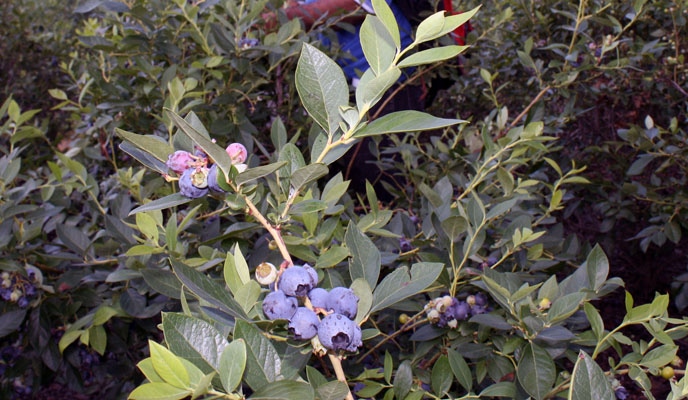
It wasn’t a bad season for blueberries in the Carolinas
Carolina blueberry growers overcome obstacles for "not bad" year in 2013.Drying blueberries after harvest was a challenge this past year.The popular blackberry variety Natchez has been subject to overcropping in the past two seasons.
January 5, 2014

The yield on Scott Barefoot’s blueberries was only average in 2013. But considering the season―a cold spring and an extremely wet summer―he was satisfied.
The Four Oaks, N.C., farmer said the cold spring caused the loss of his first crop of blueberries, and then some of his rabbiteye varieties – which ripen at the end of the season – did not attain a desirable size due to lack of pollination.
“But the yield came out to 8,000 to 9,000 pounds per acre,” he said. In a good year, he would hope for 11,000 to 12,000 pounds per acre. “But under the circumstances, I would say it was pretty good.”
The quality was not what it might have been, in part because part of the crop had to be harvested in the rain. “Our quality fell off in the later part of the season, and we may have been off by 20 percent,” Barefoot said.
As you might expect, drying blueberries after a harvest as wet as in 2013 was quite a challenge.
“We used forced air to dry our berries after cutting,” said Barefoot. “That takes time, and we lose shelf life in the process. It was especially a problem last season. We lost three days of shelf life in drying them.”
He has since taken a step to lessen that problem in 2014. “New driers are on the market that can dry everything in 24 hours so we lose only one day of shelf life,” he said. He likes those numbers. “I have two on order.”
Like many blueberry growers, Barefoot has adopted a number of different varieties to try to stagger maturity and give him a supply of blueberries to sell in the peak period. “Our marketing ‘window’ only lasts about six weeks,” he said. “Staggering gives us berries for the full six weeks.”
Barefoot’s variety lineup, from first planted to last, are Star, O'Neal, New Hanover, San Joaquin, Duke and Legacy. Those are all highbush varieties. He also plants a few rabbiteye varieties that ripen at the very end of the season. They are usually sold on the processing market.
In other berry-related news
--A very early variety is becoming available and could play a part in Barefoot’s program, he said. Called Rebel, it is a southern highbush variety with large fruit, according to literature from the University of Georgia, where it was developed.
Rebel berries are medium to light blue in color and have a small, dry picking scar and good firmness. Plants are highly vigorous, very precocious and have a spreading bush habit with a medium crown. Yield has been similar to or greater than Star in south Georgia.
--Current market conditions definitely favor production of more blueberries. “It’s no secret that blueberry consumption has been rising consistently, and planting has been rising with that demand,” grower Cal Lewis of Rocky Point, N.C., told the media this summer. Lewis, owner of Lewis Nursery & Farms, pointed to the greater availability of blueberries now due to more adaptive plant varieties as well as the fruit's growing popularity as a result of publicity about its health benefits as reasons for the increased demand. “It's been a good time for us,” he said.
--How to keep out deer: Deer are becoming more of a problem for blueberry producers, and there is considerable question about the most effective form of control. At the North Carolina research station in Castle Hayne, N.C., the best method for limiting deer-feeding damage on blueberries has been double electric fences, Bill Cline, North Carolina State University Extension plant pathologist. “Deer feed on blueberry flower buds in winter and early spring,” he says. “Feeding can severely impact yield, especially on young bushes whose buds are at easy browsing height.”
Blackberry overcropping
The popular blackberry variety Natchez has occasionally been subject to “overcropping”' in the last two seasons. That means it sometimes produces lots of fruit but not enough leaves.
“Leaves are the primary source of food for plants,” says Gina Fernandez, North Carolina State University Extension horticultural scientist. “If there are not enough leaves, the fruit will not have the sugars and carbohydrates it needs to fully ripen.”
That can be a problem, especially considering the wet spring and summer in N.C.
The fruit may not be able to ripen fully, and what does get ripe may not be very sweet, she says. “And the crop next year may be reduced because there are no primocanes emerging.”
What can you do to lessen the problem? Relatively short laterals might help.
“When you prune your laterals in the winter, don’t leave them too long,” said Fernandez. “We generally recommend 12 to 18 inches. But for Natchez, I would suggest you try to prune to the shorter part of that recommendation. That will reduce your crop load.”
About the Author(s)
You May Also Like



